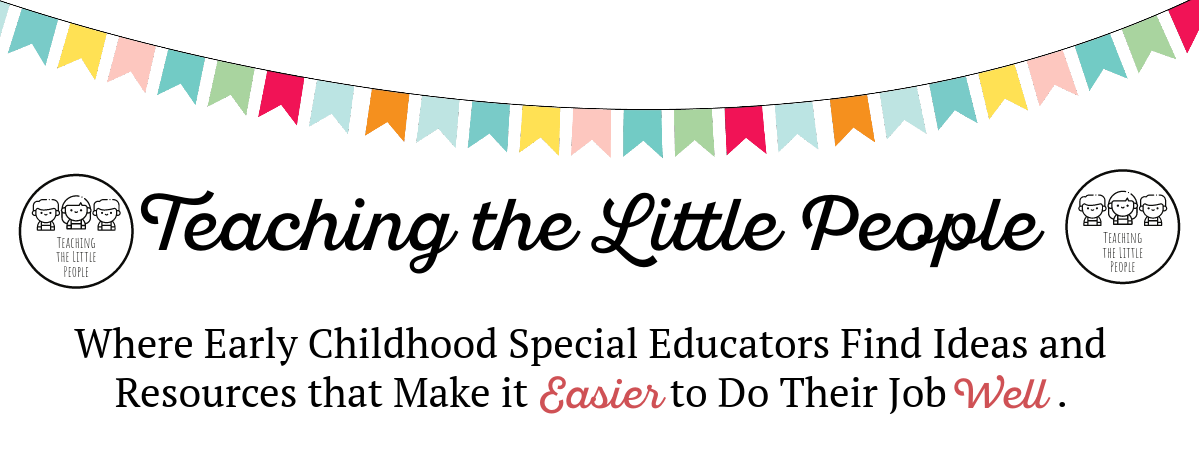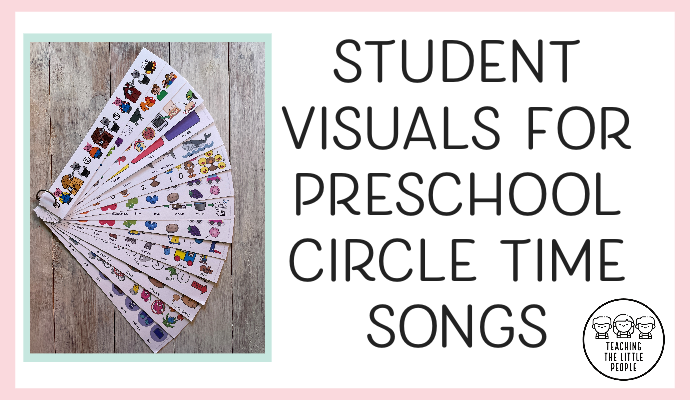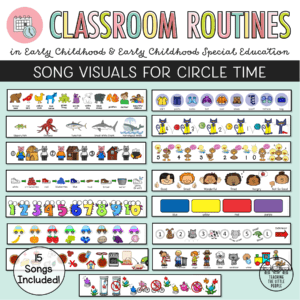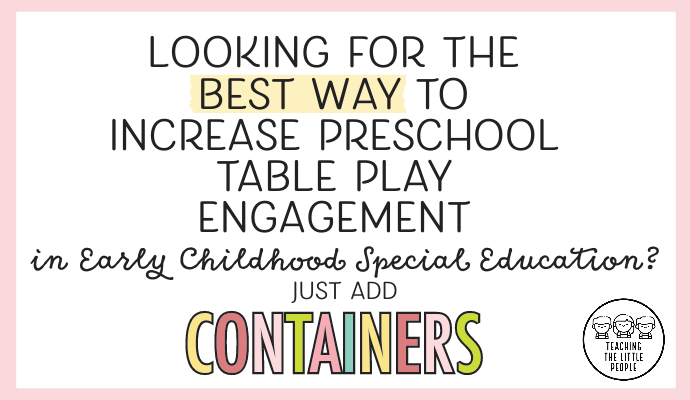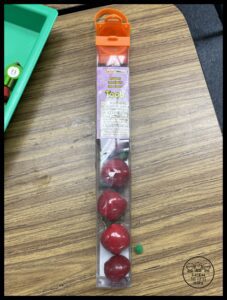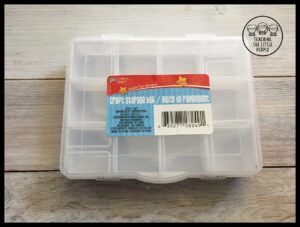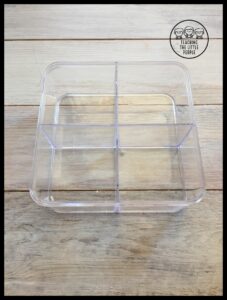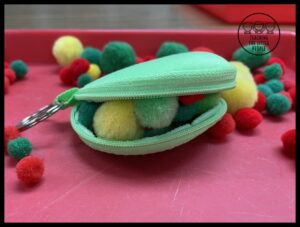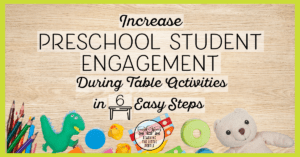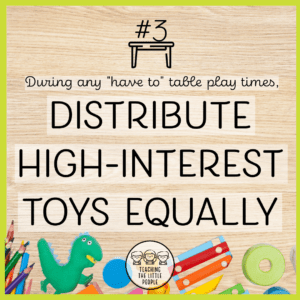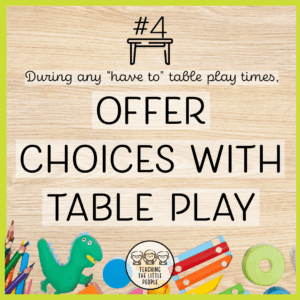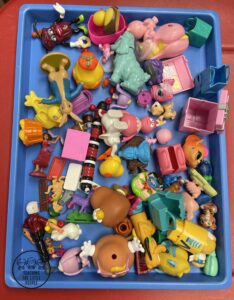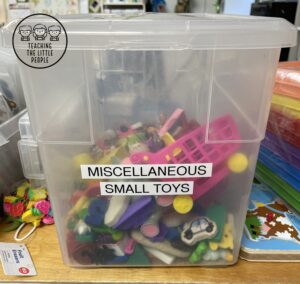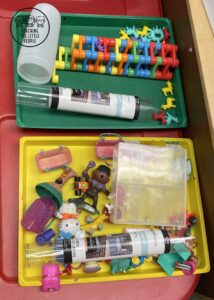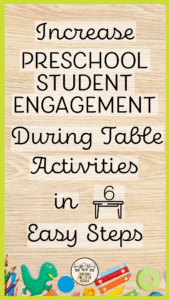Student Visuals for Preschool Circle Time Songs
As a preschool special education teacher, I am always looking for ways to make learning more engaging for my students – and easier for me. Recently, I discovered a way to gain students’ attention and increase their engagement during our circle time. This is by using these student visuals for our preschool circle time songs. I use these almost every day and am amazed at the difference they have made during our large group time.
What Are Student Visuals for Preschool Circle Time?
Student visuals for preschool circle time are pictures that illustrate songs that we use during circle time. The individual student visuals look like this:
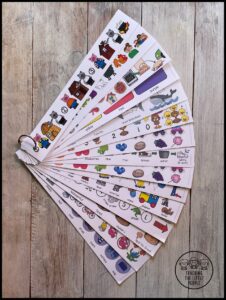
I also use larger versions of these visuals at the front of the circle time area. This allows me to refer to the parts of the song at the front of the carpet as the students follow along with their song strips.
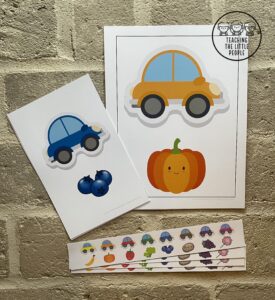
Why Use Song Visuals During Preschool Circle Time?
There are many reasons why individual preschool song visuals are such a game-changer. Here are several:
Individual Song Visuals Offer the Most Engagement Potential During Circle Time
In general, letting each student hold their own song strip visual is making the most of two other highly-engaging activities at any large group gathering: songs and song visuals.
Any experienced teacher knows that songs are a great tool to gain the attention of young students.
- Need to gain the attention of busy students? Start singing/playing a song.
- Need to encourage students to start sitting down at circle time? Start singing/playing a song.
- Need to teach a new concept? Start singing/playing a song.
In fact, when gaining interest during circle time, songs are the first step to engagement.
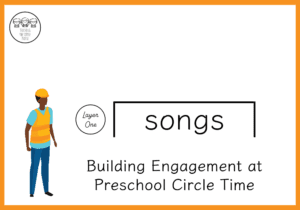
Second, adding visuals to preschool songs raises the engagement level even more. It connects the auditory and visual, which in turn, increases the interest.
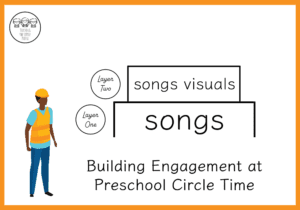
However, these song visuals take that engagement even further. By giving each student a visual, you provide them with a near-point copy of what they are hearing. It’s something they can hold in their hands, and follow along with.
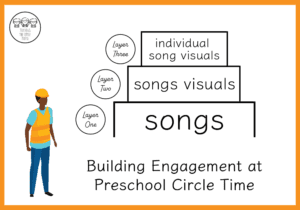
I encourage my students to follow along with the song by either asking, “Can you find it (Pete the Cat’s red shoe?) as we sing, or sometimes we add something like this tiny clothespin so they can move it along with the song.
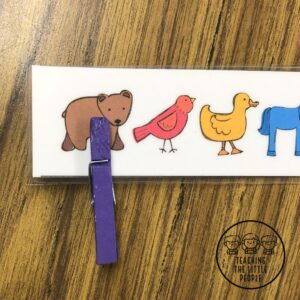
Song Visuals Can Be Excellent Invitations to “Sit Down and Get Started” at Circle Time
One of the ways to ease the transition into circle time is to start singing/playing a song as soon as it is time for the student to sit down. You don’t want to wait until they sit down and sit quietly to begin, because in preschool:
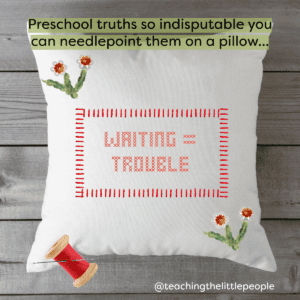 In general, if you start singing/playing something interesting, they will come much quicker.
In general, if you start singing/playing something interesting, they will come much quicker.
Song visuals are an open invitation to come to circle time. I place one on the arm of each cube chair, and they come quickly to get theirs.
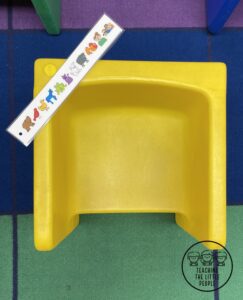
Song Visuals Promote Extra Learning at Circle Time
Another advantage of student song visuals is that they make “in-hand” visuals to work on concepts such as “first”, “next” and “last”. These are language concepts that we work on all the time in my preschool special education class, and we can apply them to the songs that we sing.
Another way you can put learning into the visuals? Use them for sequencing. You can easily cut a visual into pieces to work on sequencing skills.
Interested in your own student visuals for circle time songs? You can find them here in my Teachers Pay Teachers Store.
Looking for the Best Way to Increase Preschool Table Play Engagement? Add Containers!
A few weeks ago, I shared on the blog about ways to increase preschool table play engagement. One of the ways mentioned to increase table play engagement was to provide containers with table toys.
Today I wanted to share a little more about adding containers to play because it’s such an easy way to maximize the good things that teachers do in the classroom. In fact, have consistently found containers to be a game-changer when it comes to extending learning and engagement with table toys.
What Learning Concepts Can Containers Add to Play
There are so many learning concepts that preschoolers can learn while playing with containers. Here are just a few:
- Capacity: Do these things fit? Can I add one more?
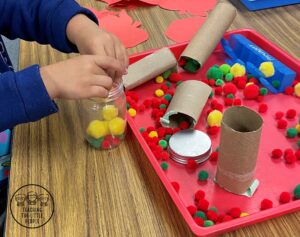
- Prepositional concepts: in & out, empty & full
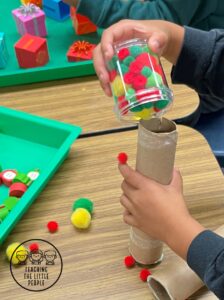
- Size Concepts: big & small, tall & short
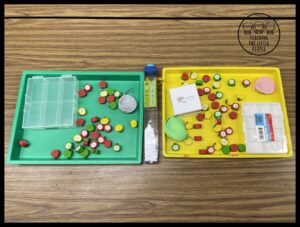
- Verbs: Put in & take out, open & close
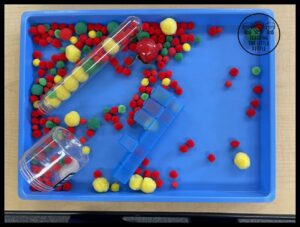
- Fine Motor: zipping, twisting lids on and off
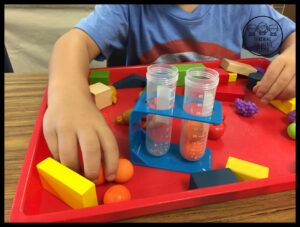
- Sorting: Often I will come across a tray of toys after school and find various objects sorted in the containers…
So many learning skills!
What Kind of Containers Work Best for Preschool Table Play Engagement?
Any kind of container works well to extend engagement during table play! That being said, free or cheap containers are the best. Here are some of the containers that are popular in my classroom:
Clear Tubes
These tend to be popular with the Little People. I think it might be because they are clear, and their narrow and tall shape creates new perspectives on capacity.
Segmented Containers
My favorite place to pick these up is at the dollar store.
Pill Storage Boxes
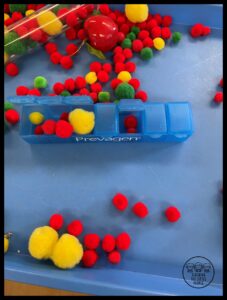
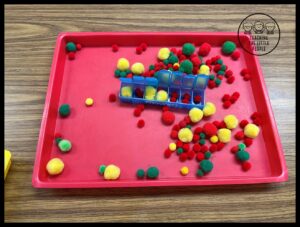
Another Dollar Tree Find
Containers with Hinged Lids
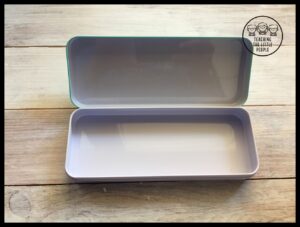
These are especially fun with magnets.
“Science” Tubes
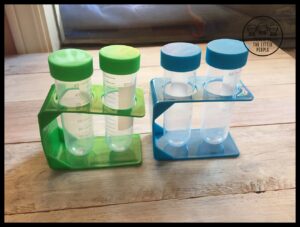
These were a great find at the Dollar Tree. The twist-on and off lids provide an added layer of fine motor practice
Zippered Containers
I find these a lot in Back to School areas. Perhaps they are for headphones?
So there you have it. I encourage you to try adding containers to increase your preschool table play!
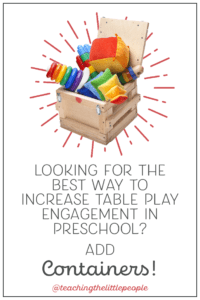
Bring a Bear Day Free Editable Invitation

Originally published: January 15, 2016
This week I finally got this year’s Bring a Bear Class Books put together – about a month after we had the event, actually. However, they look great, and the Little People are enjoying remembering the day. We do this once a year when we do our Bear Unit in December.
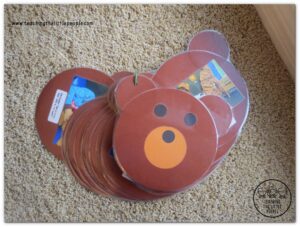
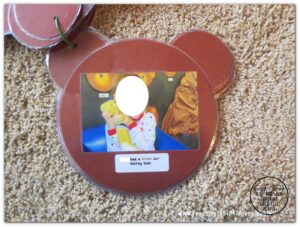 We always have some Little People bring bears, some bring other various animals, and some Little People (because they have parents like me, who never was the best at checking backpacks at night) did not bring anything. However, I always bring in a large stock of bears to have on hand for borrowing for the day.
We always have some Little People bring bears, some bring other various animals, and some Little People (because they have parents like me, who never was the best at checking backpacks at night) did not bring anything. However, I always bring in a large stock of bears to have on hand for borrowing for the day.
Here is our invitation for our Bring a Bear Day:
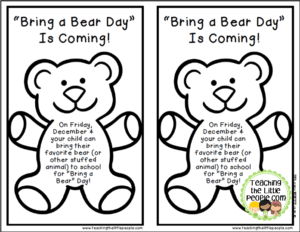
People have asked about my Bring a Bear Day Invitation, and I have finally made it into an editable version! Hurray!
When you download this pdf file, the page will look like this (except without the brand):
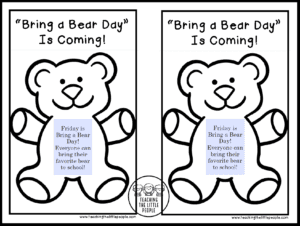
The area of text in the bear’s tummy is the editable area. If you click on it, you can completely change the text all around however you want. Use Control E on a PC and Command-E on a Mac to see the text formatting bar. The font that I used in the example above (that matches the font of the title) is called HelloFirstie, and it is part of this set of free fonts from HelloLiteracy.
As you can see, you will be able to print two copies of the invitation per paper – the text you put into one text box should duplicate to the second. (If you don’t see this at first, click on the second text box to update it.)
I hope you enjoy and can use this!
Download here:
Bring a Bear Day Editable Invitation pdfBring a Bear Day Editable Invitation pdf
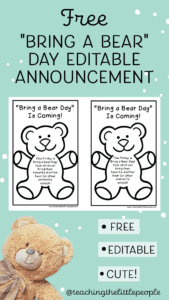
Increase Preschool Student Engagement During Table Activities in Six Easy Steps
Recently another preschool special education teacher asked me for suggestions to increase student engagement during table play activities. Preschool teachers put toys out on tables every day, and putting out things that are interesting to the students is important because interesting toys = interested students. In turn, interested students are less likely to display problematic behaviors. However, I think it is important to look beyond finding toys that prevent problem behaviors to seek toys that promote engagement. Because engagement = learning. (And yes, also prevents problem behaviors).
A few years ago, I read Engagement of Every Child in the Preschool Classroom by R.A. McWilliam and Amy M. Casey. Not only does this book explain the importance of preschool student engagement, but it also gives some excellent methods of tracking engagement in preschool classrooms. As an early childhood special education teacher, I was especially interested in what the research says about how children with disabilities engage in the classroom. According to McWilliam and Casey (2008), children with disabilities spend less time engaged in the preschool environment than children without disabilities. Therefore, promoting engagement in the preschool classroom is important to all students, especially those with disabilities.
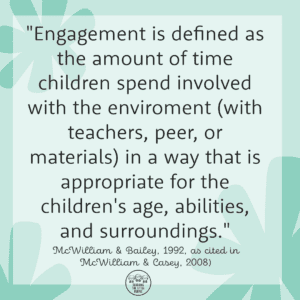
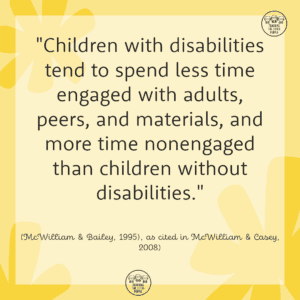
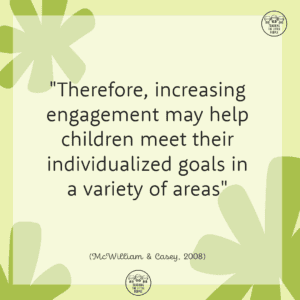
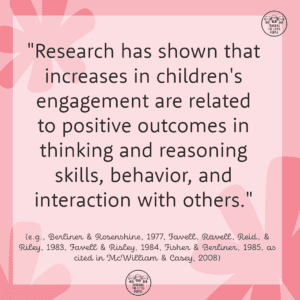
With that information in mind, what are some ways to increase student engagement in table activities? Here are some suggestions:
#1 Way to Increase Preschool Student Engagement During Table Activities: Rotate Choices Regularly – And Make Changes When Necessary
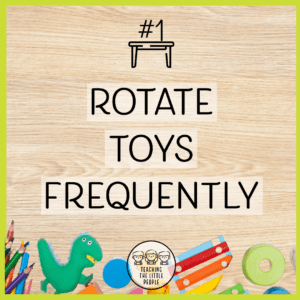 The first way to increase preschool student engagement during table activities is to ensure that toys are rotated frequently. In my classroom we generally put out one set of toys on the tables each week, then we change and have different choices the next week. However, I will keep an eye on how the table toys are being “received” – if I notice that one item is not being played with, or doesn’t seem interesting after a few days, I will add something new toward the end of the week.
The first way to increase preschool student engagement during table activities is to ensure that toys are rotated frequently. In my classroom we generally put out one set of toys on the tables each week, then we change and have different choices the next week. However, I will keep an eye on how the table toys are being “received” – if I notice that one item is not being played with, or doesn’t seem interesting after a few days, I will add something new toward the end of the week.
#2 Way to Increase Preschool Student Engagement During Table Activities: Limit Amount of “Have To” Table Play Time
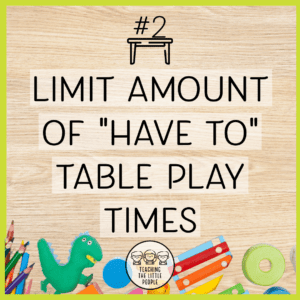
If you have a classroom schedule that has “have to” activities, you might have some part of the day when you expect your students to stay at the table for a period of time. I know this can be a little controversial, but in my classroom, we have a station time in the middle of the day where students are expected to stay at the table and play with the choices provided. While this happens, the teachers alternate working with individual students on IEP goal work. If this is something that you do, you want to make sure this is for a developmentally appropriate amount of time. We keep our stations extra short at the beginning of the school year and then add a few minutes as the year progresses.
#3 Way to Increase Preschool Student Engagement During Table Activities: Distribute “High-Interest” Toys Equally
Another suggestion is if you use any “have to” table time, you will want to ensure all the toys offered at the table are “equal”. In other words, if Johnny gets the small garage with the mini cars, and Suzy gets just blocks, there will be trouble. Students who are unhappy about not getting what another student has are not engaged. In these situations, I try to find toys about the same interest level, so everyone has the same basic thing to play with as teachers are moving around the table working with students on goal work.
#4 Way to Increase Preschool Student Engagement During Table Activities: Offer Choices with Table Play
One way to “stretch” any “have to” table time is always to have an easy second option available. For example, you can keep paper, markers, and stickers nearby during these times. If a student does not care for the toys provided, they always have an acceptable second choice. Another good option is to always provide one more tray at the table than students seated at the table so that students can always have a choice of activities.
#5 Way to Increase Preschool Student Engagement During Table Activities: Don’t Overlook Unusual Play Choices!
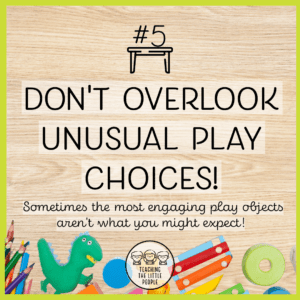
During “have to” table activities, or just free-play time, don’t forget to think about more unusual play choices. One of the most popular choices in my classroom is our “miscellaneous toys”. These are completely random small toys that I have collected from different sources. In fact, these are some of the easiest (and least expensive) things to get at yard sales. These toys are kind of the “dregs”, or leftovers of the toy box. Because they don’t have a toy home, you can buy them very inexpensively. You can see some of our miscellaneous toys in the pictures below. We always have a huge amount of engagement when we have these out.
#6 Way to Increase Preschool Student Engagement During Table Activities: Add Containers to Play Areas!
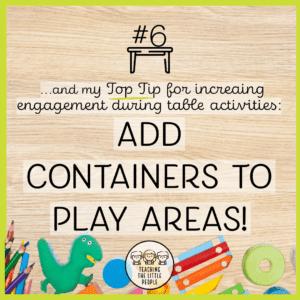
The NUMBER ONE thing I have found to improve engagement with table toys is to provide containers with any small objects. Providing containers makes the toys MUCH more interesting to them. Some good examples are zip-up pencil bags, small jewelry boxes, empty peanut butter jars, etc. Students will put toys in and out. They will experiment to see how many toys will fit. Sometimes they start sorting objects. – just because the containers are available to them. I’ve attached a picture of some containers we put out.
There are the six ways to increase preschool student engagement during table activities!
Preschool Special Education Baseline Assessments
Discovering the Potential in the New School Year with Baseline Assessments
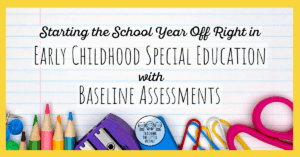
I love new beginnings. As much as I hate to leave the lazy days of summer behind and start working in the classroom again, I am always enamored with the promise that a fresh new school year brings.
One of the ways that a new school year brings promise is through the potential for growth and development for each student. It’s always exciting to see what skills and abilities our early childhood special education students have at the beginning of their time with us. It’s even more exciting to see how much they grow during the school year (and sometimes beyond, for those with us more than one school year).
One way I measure this progress is through baseline assessments. These are specific tasks that my students complete at the beginning of the school year (or whenever a new student comes into our program), and then repeat throughout the school year. These assessments provide baseline data that helps me help my students all year long.
How Can Baseline Assessments in Preschool Special Education Help You?
There are several ways that baseline assessments can help you in your preschool classroom. Read on to find out more.
Baseline Assessments Provide a Starting Point for Later Reference
First, these assessments create a “ruler” by which we can measure future progress. According to Beeve and Springer (2020), “In order to truly measure the learning, growth, and development of a child over time, there needs to be a point of reference, or a starting point. Baseline data provides a starting point” (p. 38). By creating these points of reference any time a new student comes to us, we create a frame of reference by which to measure future progress. This ruler will either show progress that tells us our interventions are effective or will indicate areas that need adjustment.
Baseline Assessments Help You Focus on Very Specific Areas of Need
Strong baseline assessments indicate where a student is in the development of a skill. By giving students a range of task levels (described below), you are able to tell precisely what a student can and cannot do in a developmental continuum of skills.
Baseline Assessments in Preschool Special Education Can Be an Indicator of Summer Regression
Another way that baseline assessments can help you in your early childhood special education classroom is to indicate possible student regression from the summer break. In the case of returning students (where baseline data was also gathered the previous school year), beginning-of-the-year baseline assessments can indicate regression. This data is important when considering Extended School Year services for a student.
Baseline Assessments Give You a Concrete Way to Share Student Progress with Parents
Finally, while we can use words to describe the progress of students, having concrete examples can be even more effective. One of the most rewarding ways to use baseline assessment baselines is to use them as “before/after” examples to show parents their child’s progress. While parents hopefully have been noticing the individual work papers as they go home throughout the school year, it is especially meaningful to show a comparison of “The first time Johnny tried to write his name”, and “How Johnny did the most recent time he tried to write his name”.
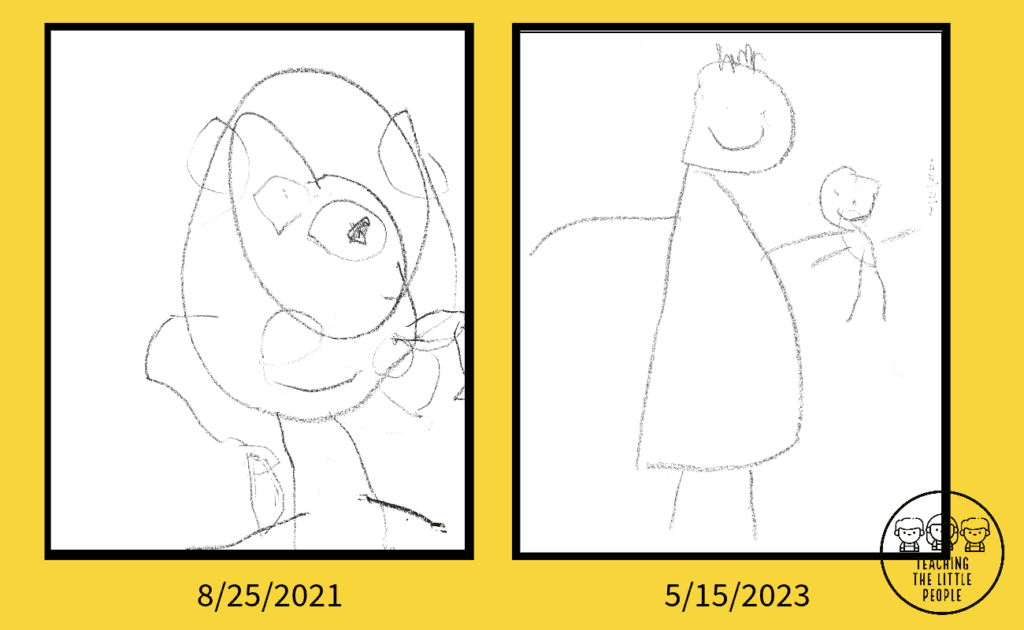
What Activities Make Good Baseline Assessments in Preschool Special Education?
While baseline assessments can be valuable in any educational setting, not all activities make good baseline assessments. When considering what baseline assessments to use with new students, here are a few things to consider:
Baseline Assessment in Preschool Special Education Should Be Developmentally Appropriate
First, baseline assessments should be appropriate for the student’s age or development level. Let’s look at this in terms of fine motor baselines. As an early childhood special education teacher, I would never assess a student’s fine motor ability by asking them to draw a detailed picture or write something in cursive. Instead, I am going to focus on activities and skills that students are able to do at preschool age. If you are having trouble deciding what is appropriate, a professional curriculum or formal developmental assessment should help provide a framework for developmentally appropriate tasks.
Baseline Assessment in Preschool Special Education Is Individualized to the Child
Second, teachers should take into account any known developmental issues. For example, in the area of fine motor skills, a student who lacks motor control because of a known medical issue might be at the same level as a typically developing student. (This is not to say that students with differing physical abilities are not able to complete more complex fine-motor tasks. It is just a statement that you should be aware of and open to all levels of ability before you limit a student to a specific range of activities.)
Baseline Assessments Should Be Activities That Students Will Be Working on In Your Classroom
Third, baseline assessments should be the types of activities that your student will be working on throughout the school year. When thinking about what baseline data to collect, consider your teaching context. Think about the skills that you most often need to work on during the school year with your students. You should consider these activities as first baseline assessment activities. In the area of fine motor development, all of my students work on writing in some form. Either these skills are part of IEP goals, or these are the types of fine motor development we work on as part of our program as we are guided by state preschool standards. Therefore, these aren’t “one and done” activities – these assessments are followed by routine program activities – and the routine activities in turn should support stronger baseline assessments.
Baseline Assessments in Preschool Special Education Should Cover a Range of Skills
Baseline assessments should cover a range of abilities, to provide a wide-angle lens of the students’ ability. The reason for this is two-fold. First, a student may be more or less skilled than you are expecting for various tasks. Second, even if students are not able to complete a task, you will still keep their first attempts. These first attempts will serve as a power comparison against future successful attempts.
For fine motor baseline assessments, I have students complete several tasks that fall within a continuum of fine motor skills. These are:
- Imitate lines and prewriting shapes after watching an adult from them. We look at vertical lines, horizontal lines, a circle, a cross, and a “V”
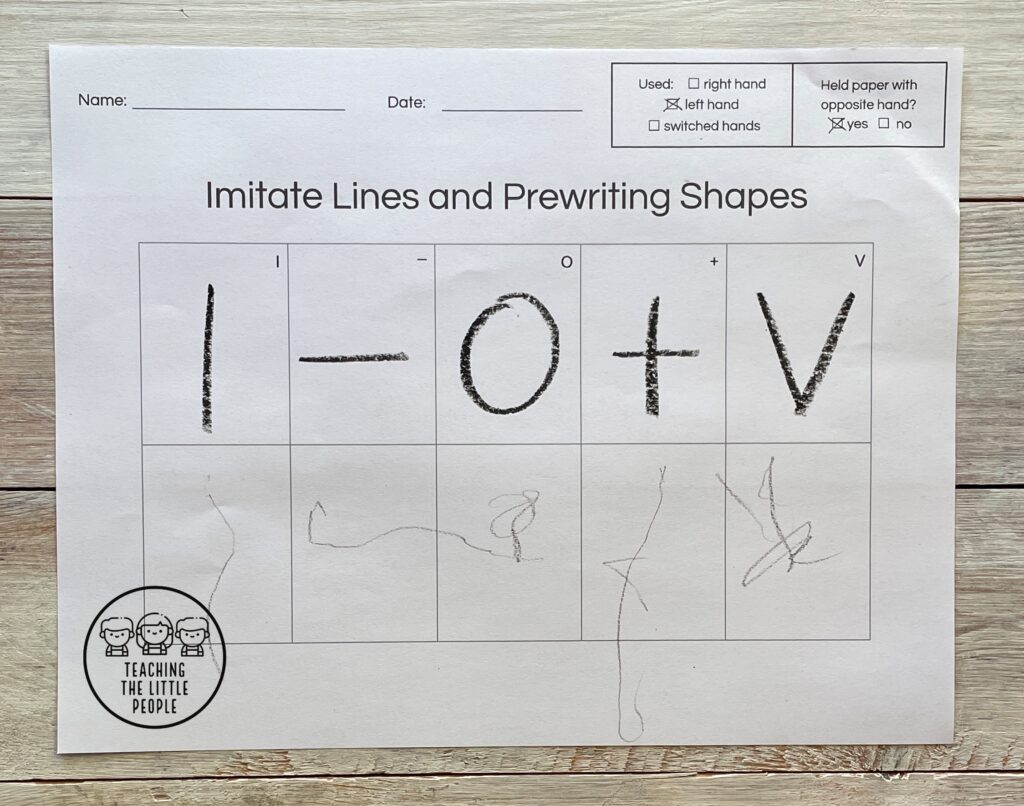
2. Imitate letters of first name.
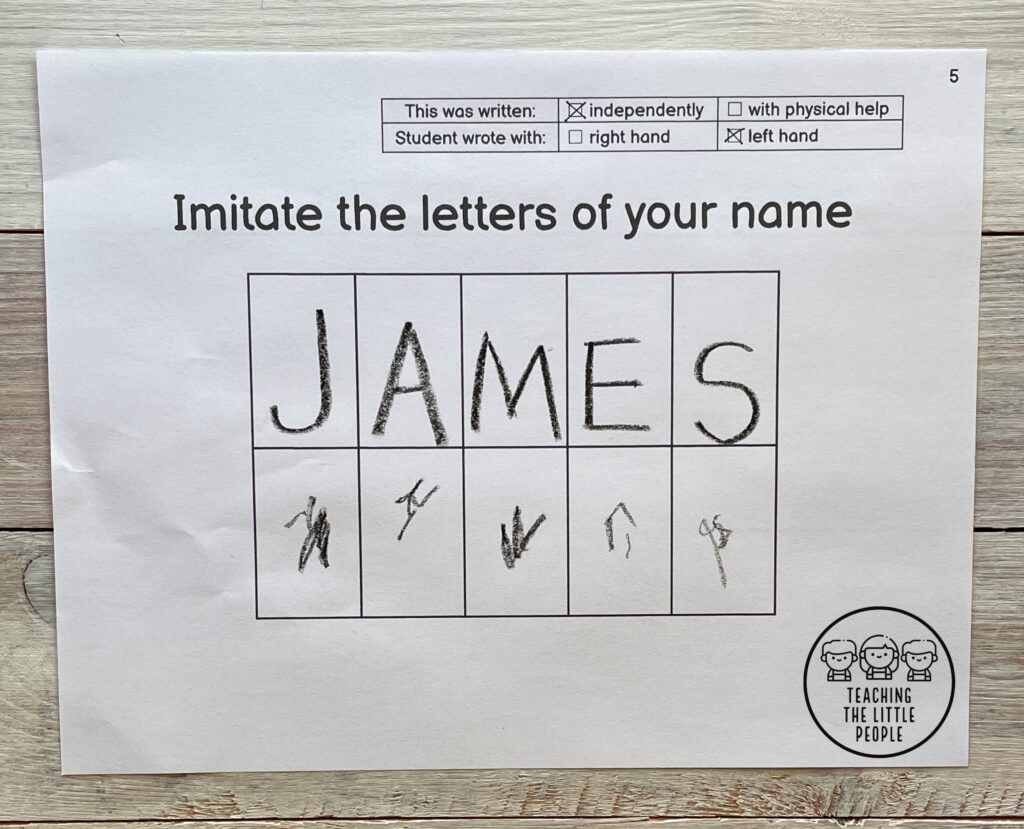
3. Copy letters of first name from a model
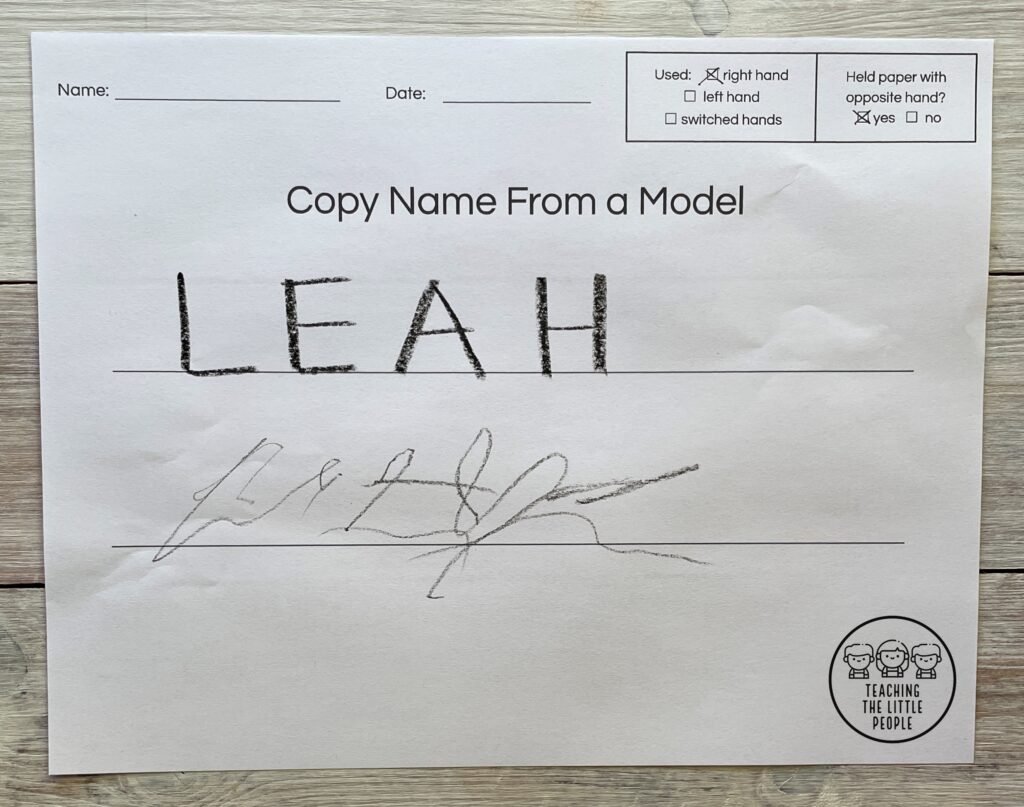
4. Write first name without a model
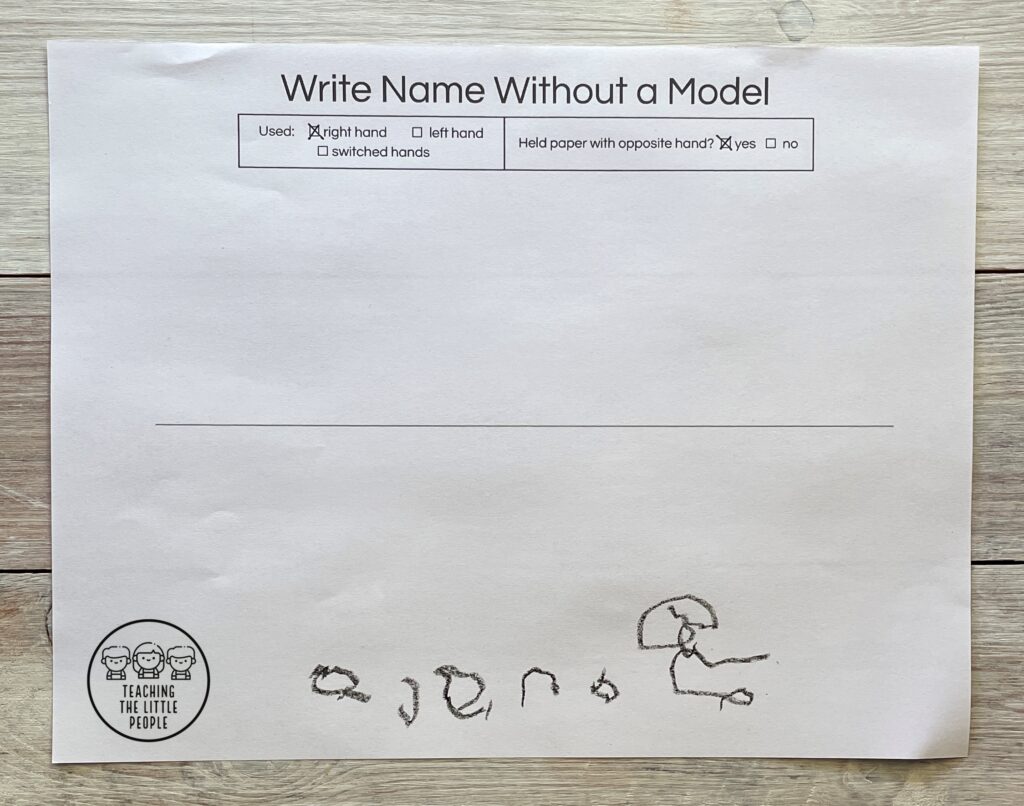
5. Draw a person.
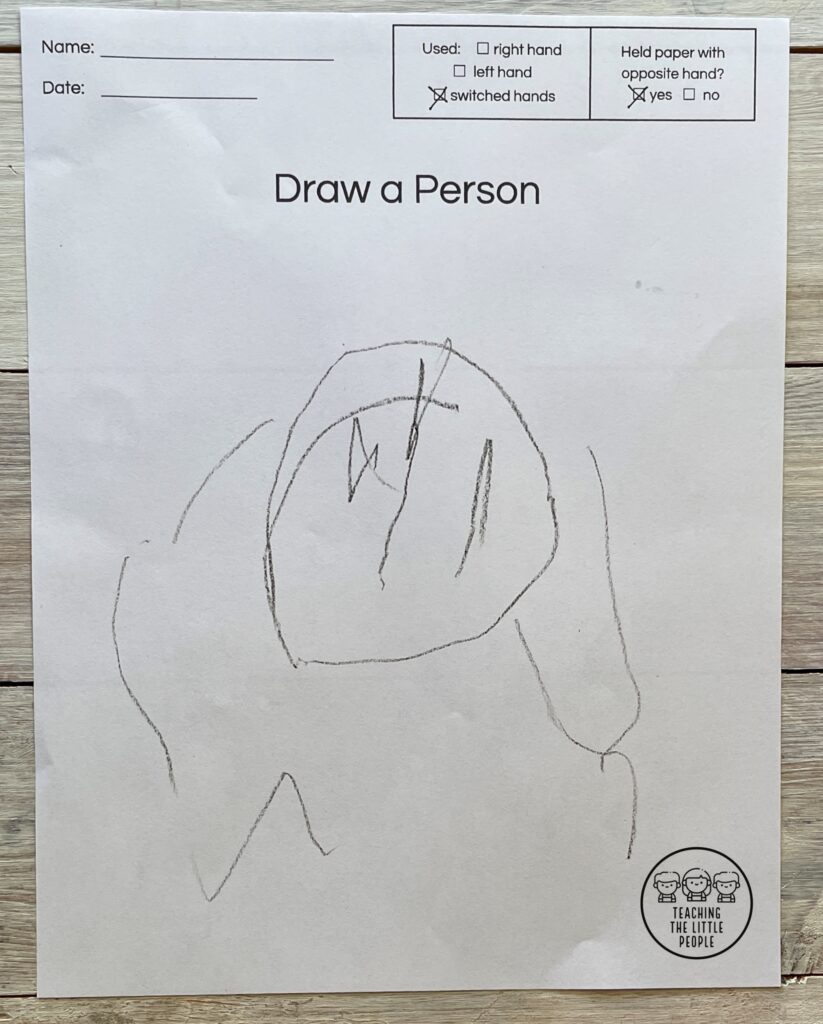
Using this range of activities allows us to cast a “wide net” of skills. This gives us a good sense of both what each student can do, and what they need to work on.
Baseline Assessment Should Be Repeated Throughout The School Year
Finally, baseline assessments are most valuable when they are repeated throughout the school year. When these are activities that students are usually completing during the school year, this should not be hard to do. However, there is a difference between working on specific skills and checking baselines. For example, perhaps I discovered from baseline assessment probes that Johnny can imitate vertical and horizontal lines, but not curves. From this, we know the specific area to focus on with Johnny’s fine motor work. However, I am still going to periodically check his ability to do the more difficult fine motor skills in the baseline group, just to see how he is progressing on each of these.
Informing Parents About Baseline Assessments
When I am working with new students and am giving baseline assessments, I want to communicate with parents about my plan. I send home this paper to inform them of our plan for these activities. This assures them that I am not expecting their very young child to perform tasks that are currently too hard for them.
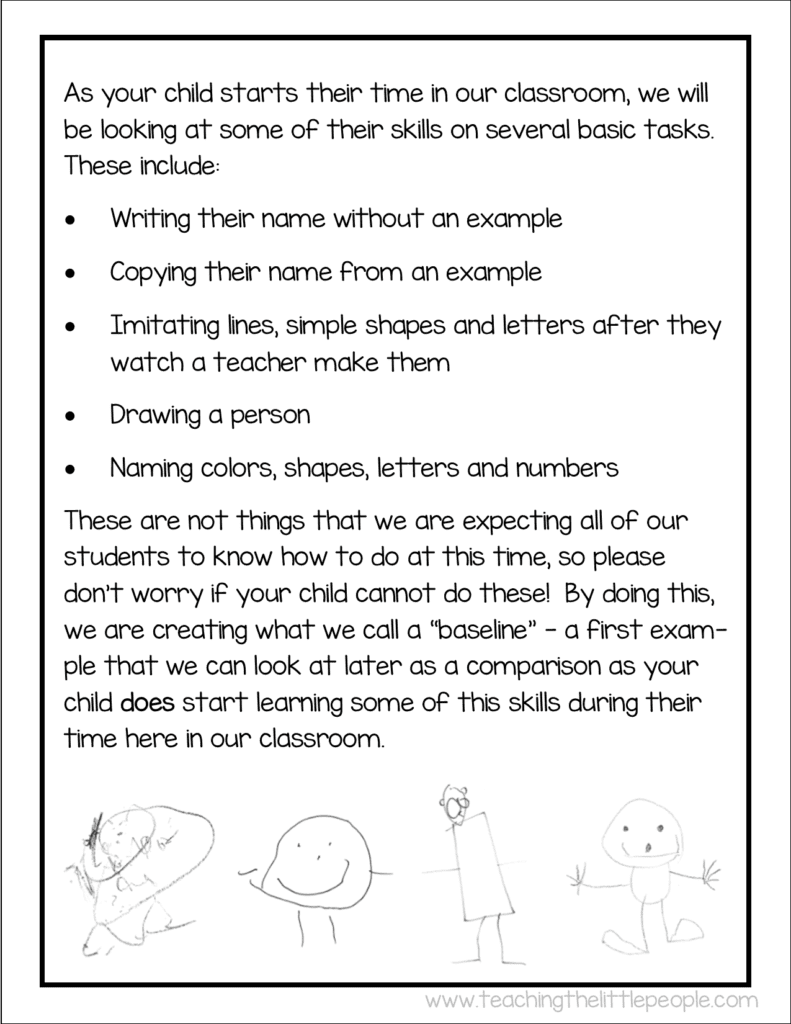
Want your own copy of this paper? You can download those free here for a limited time.

The Fine Motor Assessments That I Use for Baseline Data
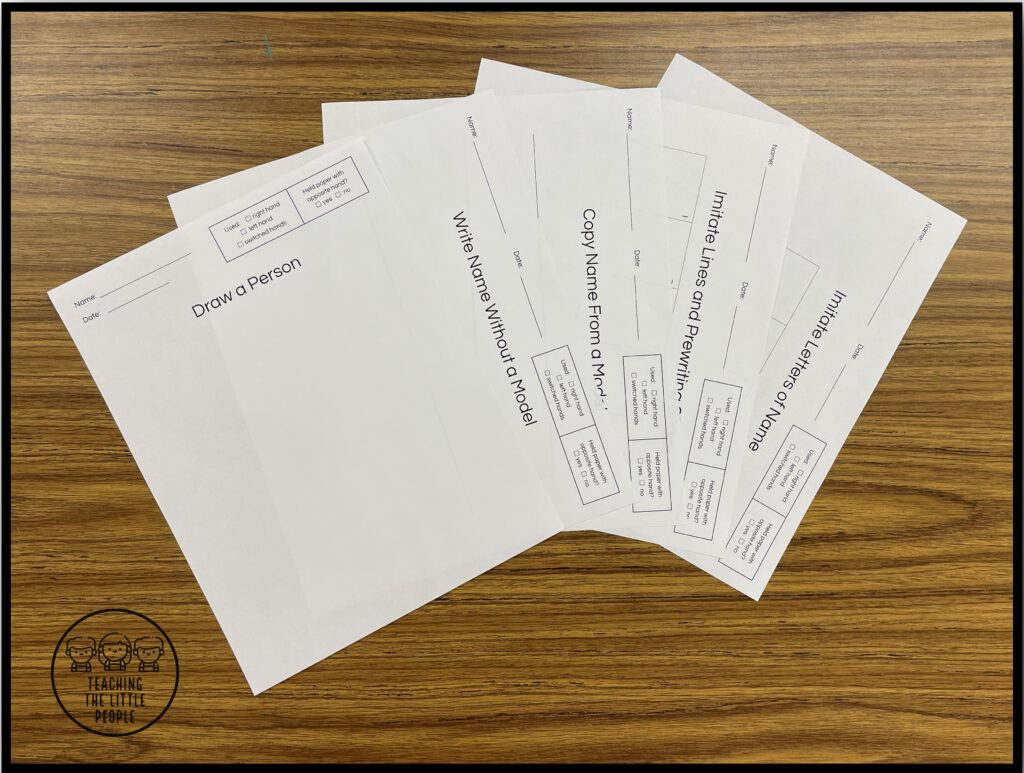
Want copies of the fine motor baseline assessment papers that I have described here?
I have included them here as a download for a limited time to get you started on the path of baseline assessments in your classroom.


Three Important Teaching Priorities for Early Childhood Special Education
.
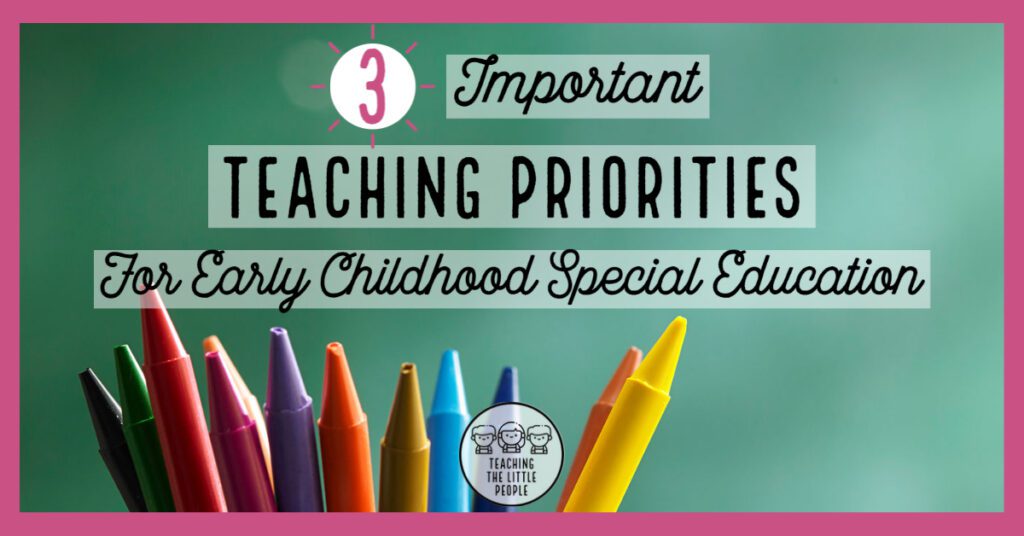
Priorities of Early Childhood Special Education
Are you an early childhood preschool special education teacher who sometimes struggles with what your priorities should be when teaching your students? You know students’ IEP goals are essential, but what about the other things? What about all the skills that are not included in the IEP goals? How do you balance all the other things they need to know?
I know that I struggle with those questions sometimes. When that happens, it helps to ground myself in the following three specific teaching priorities for early childhood special education.
Teaching Priority for Early Childhood Special Education #1: IEP Goals
Because of the nature of IEP goals and my legal responsibility to work to meet them, they are my first priority in my ECSped classroom. Because of this, I spend a lot of time planning and implementing activities that address each of these goals.
That being said, it is also essential to ensure each student has the best (and most functional goals). The best goals are not general goals pulled from the “preschool development area”. The best goals are ones written specifically for the needs of each student. Kristie Pretti-Frontczak and Diane Bricker (2011) state, “When prioritizing, teams should select goals that 1) are not likely to develop without intervention, 2) significantly enhance a child’s behavioral repertoire, 3) enable the child to be involved in the general curriculum/daily activities, and 4) match a child’s developmental level of performance”. Therefore, it is not only important to just focus on meeting a child’s IEP goals (that perhaps they came to you with) – it is also important to ensure that every child has the best goals for them.
Teaching Priority #2: State Preschool Standards
In general, we also work on skills covered by our state preschool standards. These are areas that might fall out of the range of their IEP goals. These areas are shown by my graphic above and are listed here:
- Language: Teaching students to use words (or pictures or appropriate actions) to get what they want, think, and need. Even though a Speech/Language Therapist spends two days a week with us, I still try to work on language constantly – it’s just that important.
- Math Skills: Numeracy, Spatial Concepts, Comparative Concepts
- Early Literacy: Letter Skills and Phonetic/Phonemic Awareness
- Fine/Gross Motor: Establishing and Refining the small and large body skills to accomplish age-appropriate tasks
- Social/Emotional (which includes Behavioral): Self-Regulation and Interacting with Others
A strong preschool curriculum will provide you with activities and concepts to work on that will help students develop in each of the areas mentioned above.
Teaching Priority #3: General Preschool Knowledge
I think of “general preschool knowledge” as broad, thematic knowledge and experiences that increase the knowledge base of my ECSped students.
In many ways, general preschool knowledge exposure and acquisition is the vehicle for working on students’ IEP goals and preschool standards. By carefully addressing specific skills during teaching themes and learning units, you can address IEP goals and more general preschool skills in a well-balanced, functional way. (As opposed to addressing individual skills in a “focus just one skill at a time”, more splintered fashion.) Plus in my opinion, it’s a lot more fun teaching this way.
It is easy to teach this way? Not always, because you have to put effort into knowing what materials and activities address which skills. You also have to know that for each theme or learning unit that you teach. However, knowing how to do this (differentiating fun, thematic instruction to focus on specific skills within each theme) and doing it well is what I enjoy most about teaching early childhood special education, so stay tuned here on the blog to find out ways to do that.
Citation: Pretti-Frontczak, K., & Bricker, D. (2004). An activity-based approach to early intervention. Brookes Publishing Company. PO Box 10624, Baltimore, MD 21285.
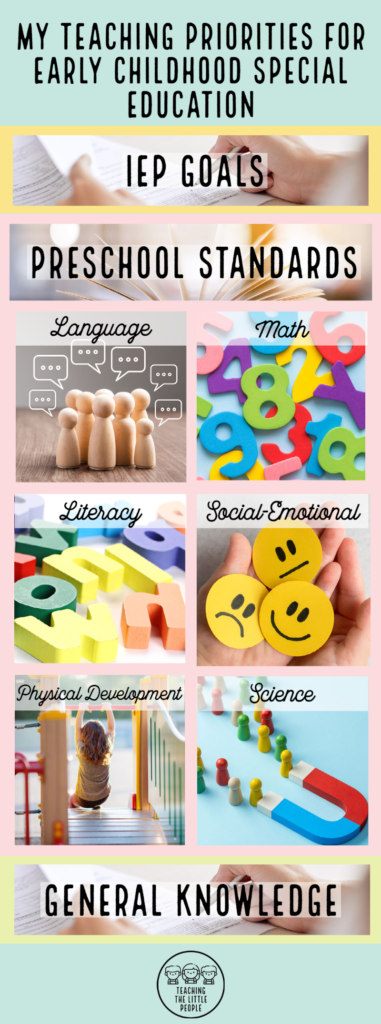
Starting Over with the Teaching the Little People Blog
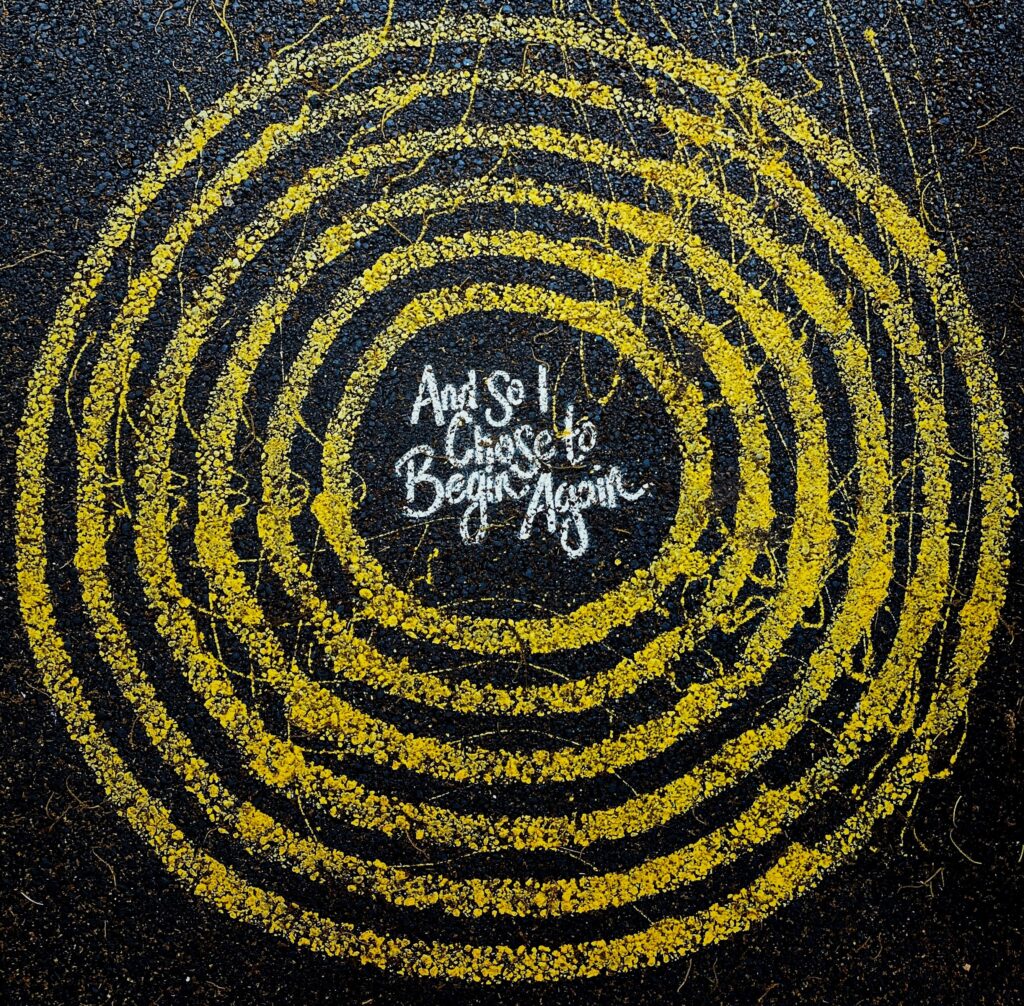
Welcome to the new Teaching the Little People blog. While my purpose of sharing things I know about early childhood special education here is the same as it has been in the past, this blog itself is brand new. That is because…I lost the old blog. I had been away from posting for several years, and let a few (vitally important) things slip. Then, when I decided to start posting again, I went to my site provider and discovered that it was no longer there. Because I very sadly didn’t have a backup (yes, lesson learned), I am not starting over.
However, there are a few advantages to starting over. Because I am really starting over (and not just picking up where I left off after a long hiatus), I had to put some thought into whether I wanted to continue posting at all. I knew I would also have to relearn some things about creating a website and setting it all up, which has always been a challenging part of the process for me. So, I had to decide whether I wanted to go all in on this process, or just continue the way that I was (which was not posting at all).
However, I do feel that I have learned some things about early childhood special education that can be helpful to other teachers. I see other teachers struggling with this job almost daily during the school year, and I want to do what I can to share what I have learned. Because of this, I am starting over. Thanks for joining me on this journey!
